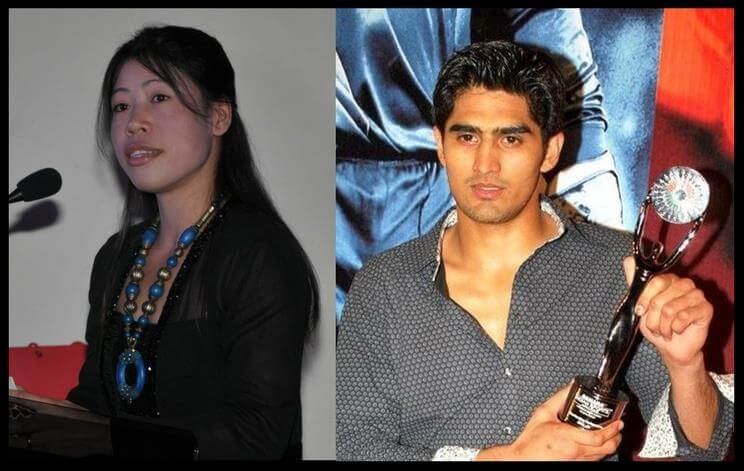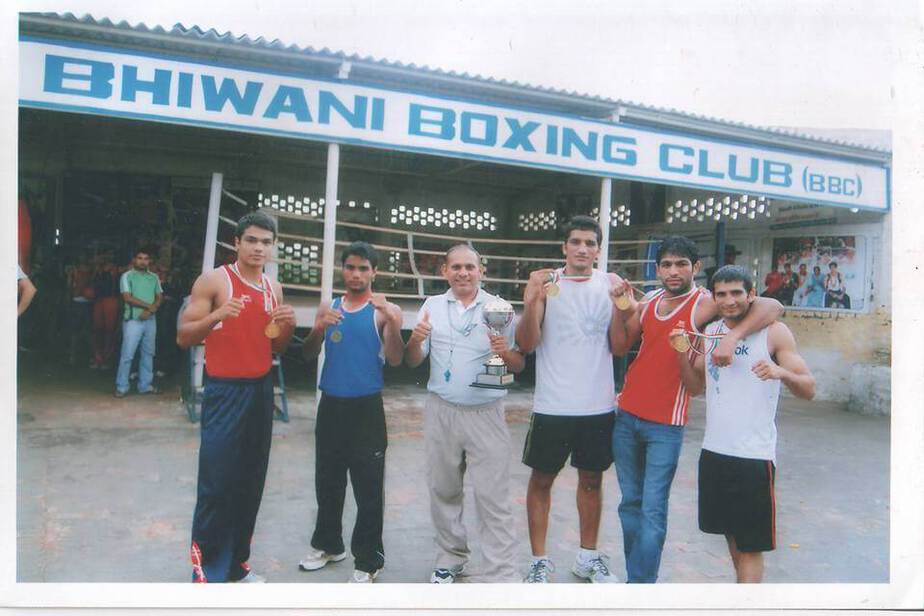In modern-day India, the game of boxing does not command a significant fan following, which commentators often attribute to the lack of discernible international victories. However, despite India’s limited success at large global championships, it is a regular medal-holder at the Asian Games and Commonwealth Games. Mohammad Ali Qamar became the first Indian to win a gold medal at the Commonwealth Games in 2002. At the 2008 Beijing Olympics, Vijender Singh won a bronze medal in the middleweight boxing category, while Akhil Kumar and Jitender Kumar qualified for the quarterfinals.
This interactive depicts some of the major Boxers in India and their achievements according to the location of their Boxing clubs. (Hover over the dots to see player profiles)
Ask any avid follower, and they’ll tell you that Haryana and Manipur are undoubtedly India’s Boxing strongholds. Vijender Singh, who briefly reached World No. 1 in the middle-weight (75kg) category in 2009 hails from Haryana; Mary Kom, a five-time World Amateur Boxing champion, the first Indian woman boxer to win a gold at the Asian Games (2014 Asian Games), and quite possibly the face of female sports in India, comes from Manipur.

With the establishment of the Super Boxing League this year, with the support of the World Boxing Council and the Indian Professional Boxing Association, the sport’s future looks bright. However, if we take a look at the past, one glance would tell us that the road to get here has been anything but swift.
The Story of Bhiwani
Several famous Indian boxers – take Vijender Singh or Akhil Kumar – have emerged over the past decade from the small town of Bhiwani in Haryana. Bhiwani is no stranger to international wins. Home to at least 1,500 regular boxers and 20,000 active sportspersons today, the town thrives on local sportsmen making it to the sports quotas of the Indian paramilitary forces, Indian police and Indian Army. It has produced as many as 14 Arjuna awardees – the country’s top honour for sportspersons.
Most of the credit for this goes to the Bhiwani Boxing Club, whose coach Jagdish Singh became a national hero once boxing stormed into the limelight. The momentous occasion was Beijing 2008, which saw a vast audience celebrating the achievements of Vijender Singh and Akhil Kumar, both products of this club.

The town’s rise to sports eminence can be traced back several decades. Bhiwani and Indian boxing had their first tryst with international success way back in the 1960s when Hawa Singh won gold at the 1966 Asian Games in Bangkok. He followed it up with another gold at the following edition in 1970, and this gave rise to a boxing culture that has since flourished in this town. No funding was directed towards it, but that didn’t dampen the gung-ho spirit of Bhiwani’s boxers; if Hawa Singh could do it, they told themselves, so could they. The mid-70s and 80s were trying times for the town, with several of its youth leaving for neighbouring states in search of sufficient work and a decent livelihood. Local discontent over the Government’s apathy peaked during the late 80s, with unemployment leading to high levels of frustration. Sports offered hope – given half a chance, locals were ready to adopt competitive games with gusto (this is also seen with the athletes of Manipur).
In the early 1990s, the Sports Authority of India (SAI), an apex sports governing body, set up by the Government of India in 1984, started a training school for boxing at Bhiwani (SAI’s first organized sports facility) to encourage the sport. SAI was prompted by the success of Raj Kumar Sangwan, who won golds at two Asian-level meets (at Bangkok in 1991 and Tehran in 1994). However, this solitary SAI facility offered little by way of training infrastructure. It was the Bhiwani Boxing Club, hardly a modern facility itself, that ultimately made the difference. The club, in much better shape today, was once just two rooms and a shed. However, as witnessed from the numerous success stories, the lack of infrastructure can be more than compensated for by a passion for boxing, backed by discipline and dedication.
Many of Bhiwani’s boxers came from remote and long-neglected parts of India, where training facilities and coaching do not exist, and where sports as a profession is not encouraged. However, the Bhiwani Boxing Club allowed and enabled these sportsmen to make a living and a name for themselves, despite there being almost minimal administrative and financial support for the Club or the sport in general.
Looking ahead
The Ministry of Youth Affairs and Sports has recognized Boxing Federation of India (BFI) as the National Sports Federation (NSF) for Boxing. This decision will give a massive boost to the sport of boxing, it has been severely suffering due to the absence of an NSF since 2012; The Indian Amateur Boxing Federation (then the NSF) was terminated for manipulation in elections. BFI conducted its elections of its office bearers in September 2016, and the AIBA has recognized these newly elected office bearers of BFI.
The recognition that the BFI has received, coupled with the emergence of the Super Boxing League, is bound to push Boxing back on the right track. However, the presence of a statutory body in the country for the sport of boxing does not imply results. Greater support must be given to local projects, such as the Bhiwani Boxing Club, to promote the sport and incentivize more and more Indians to take up professional Boxing. Appropriate changes in the infrastructure, management and attitude towards the sport are required to bring about a long-lasting and systematic impact for the sport in India.
Featured image source.






